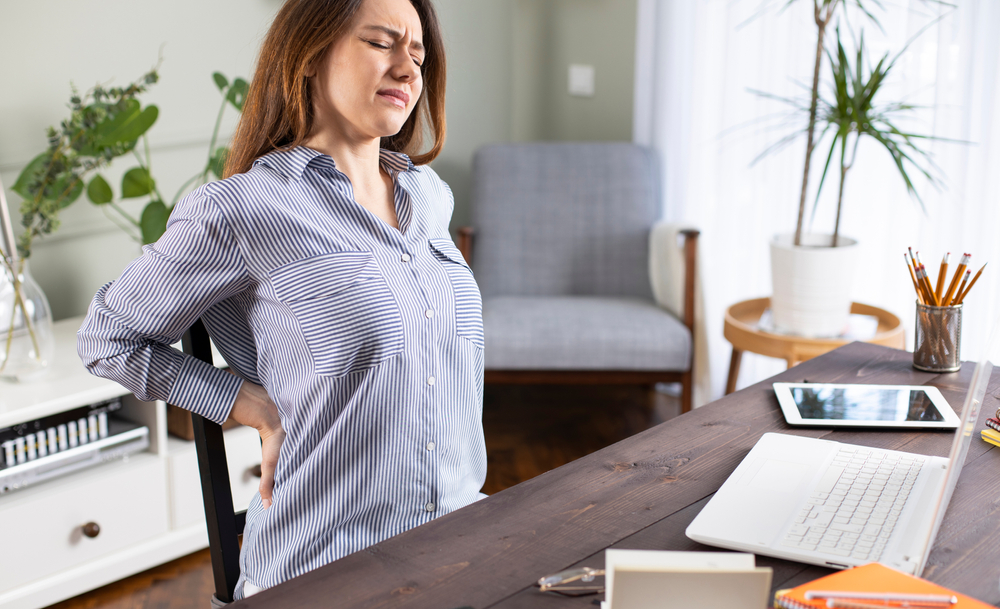Are you working from home?
Are your kids being homeschooled?
Are you on a laptop, tablet, or desktop?
Having Neck Pain or Lower Back Pain?
The Lockdown Blues (#WFH)
Being lockdown and stranded at home has been difficult for many families. Working from home has been a difficult adjustment for many Americans during this COVID-19 pandemic. While a few of us are already returning to work, many are stuck in this new normal of remote workplaces indefinitely. We are no longer spending 8 minutes hunched over our phones before bed, we’re spending 8 hours staring at our laptops and other devices, every day. Extended periods of awkward posture can eventually lead to lower back pain and may require chiropractor intervention.
 The Home Office
The Home Office
Whether you’ve set up a separate home office or are trying to work from the dining room table, neither is likely to be as ideally set up as your ergonomic office at work. Your home office needs to be a safe and healthy places to work, and we at Divine Spine Yorba Linda want to help. We’re offering some tips to make easy, inexpensive adjustments to your workspace in order to stay productive and mindful of your spine’s health. Why? If you don’t pay careful attention to your home working environment, you are most likely going to see pain set in. By this we mean, neck pain from constant slouching and hunching over your desk, lower back pain from not supporting your back properly, sciatica pain should you end up not moving much with constant sitting and with that comes immobility, depression and much more!
Tip #1: Customize your workspace
When you get into a car to drive it for the first time, what do you do? You adjust the seat so you can reach the pedals and see the road easily. You move the mirrors to make sure you have a clear line of sight behind you and to either side. You may even change the headrest position and the seat belt height too. When working from home, it’s important to make similar adjustments. Ergonomics is defined as the science of fitting a workplace to the user’s needs. Adjust the tools you use in your home office to meet your specific body and needs. If there is a task that you do for extended periods of time, then customize your setup to be safe and comfortable for that specific task. Consider your desk, chair, monitors, keyboard, and lighting. Doing so reduces your chance of injury and increases your comfort, all of which help you stay productive and focused. Make sure your if you are working with a computer that you are not hunched over it.
Tip #2: Treat your laptop like a monitor
Laptops make working from home possible for so many of us, but they can be a big problem for our spine. There’s no such thing as good laptop posture, but with a few modifications, you can avoid some of the nasty side effects you’ve come to expect. To protect your neck, you should be looking straight ahead. Using an external keyboard and mouse enables you to prop up your laptop at eye level. This way, your back won’t be hunched forward and your elbows can be bent at a comfortable 90 degrees. A portable laptop stand can raise the screen or a stack of books can be used as a budget option.
Tip #3: Get comfortable
Find a posture that allows you to see the screen while sitting back in a way that provides lower back support. You might find it’s similar to sitting in the driver’s seat of a car, slightly leaning back. If you can’t buy an ergonomically-correct, comfortable chair, try making adjustments with a cushion, pillow, or towel behind your lower back. Or consider an orthopedic seat, a saddle-like products that works with any chair. Shorter people might also find that having a footrest helps them achieve the right posture. Make adjustments until you find a comfortable seated position.
Tip #4: Don’t just sit there
Get up and stretch every 20 – 30 minutes. If you are stuck sitting in one place for long periods of time, try setting a reminder alarm on your phone to help you remember to stand up and stretch periodically. Also, if you can do some of your work while standing, maybe by using a standing desk or just while talking on the phone, that’s a good way to make sure you don’t stay stagnant. If you own a Fitbit, set it to remind you to move. Try to get in 10,000 steps throughout the day, this should be a good indicator that you have done enough moving for the day.
We know this is a particularly trying time and we want to help. We can provide you with some exercises to do while working at home to help strengthen the muscles supporting your spine. We have both telehealth and in-office visits available at our Yorba Linda location. We ask that you do not come into the office if you are having a fever or show any symptoms described by the CDC, but instead schedule a telehealth consultation which is complimentary. Remember Movement is Medicine, keep moving but remember to keep your posture right.
For more information on lower back pain click HERE
For your initial consultation contact us HERE


